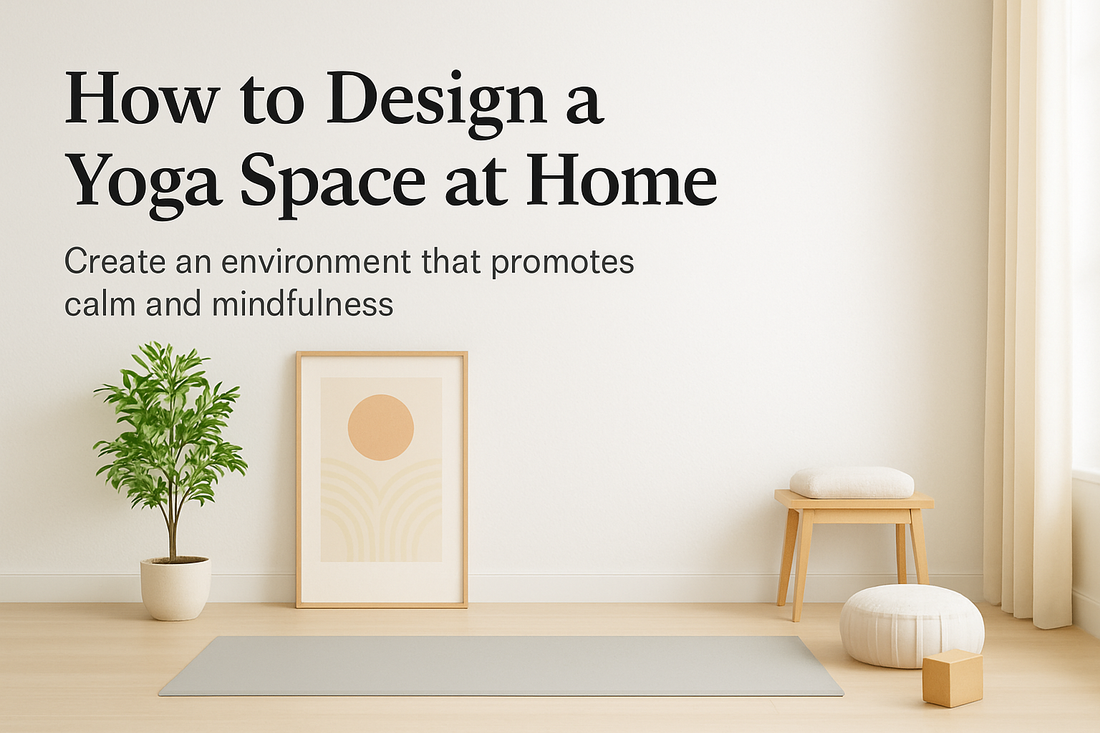
Designing Your Yoga Space for Mindfulness and Joy
Creating a peaceful, inspiring space at home for your yoga practice can completely transform how you feel about stepping onto the mat. Your environment plays a powerful role in shaping your mindset — the right atmosphere can encourage mindfulness, reduce distractions, and make your practice feel like a personal retreat.
Whether you have an entire room to dedicate to yoga or just a cozy corner, this guide will help you craft a space that’s welcoming, functional, and filled with positive energy.
1. Begin with Decluttering and Intention
Before you add anything new, clear out what you don’t need. A cluttered space often reflects a cluttered mind, which can make it harder to focus during practice.
As you declutter, think about your intention for the space. Is it purely for yoga, or will it also be used for meditation, breathwork, or journaling? Knowing the purpose will guide the design choices you make.
A good practice is to keep only what inspires calm and positivity. Soft lighting, natural elements, and minimal distractions will help your yoga area feel like a sanctuary.
2. Choose Colors that Soothe and Inspire
Colors affect mood more than we realize. For a yoga space, gentle earth tones, soft pastels, and muted greens or blues tend to promote tranquility.
You don’t need to repaint an entire room. Even small touches — such as a pastel yoga mat, calming wall art, or light-colored curtains — can make a noticeable difference.
If you’re practicing in a shared space, consider portable elements like screens or drapes to visually separate your yoga area from the rest of the room.
3. Bring in Nature’s Calm
Yoga and nature go hand in hand. Adding natural elements like indoor plants, woven baskets, or bamboo décor can infuse your space with a sense of serenity.
Plants not only add beauty but also improve air quality. A few low-maintenance options such as snake plants, peace lilies, or pothos can enhance your space without demanding much care.
A small water fountain or even a bowl of fresh flowers can also introduce soothing natural energy to your yoga corner.
4. Set the Mood with Scent and Sound
Creating a multi-sensory experience can deepen your practice. Calming sounds like soft instrumental music, chimes, or nature-inspired playlists can help you focus and unwind.
Scent is just as powerful. Many practitioners love using candles, incense, or diffusers to create a sense of peace before practice. A delicious fragrance of lavender, sandalwood, or eucalyptus can instantly shift your mood, reduce stress, and make your space feel more inviting.
Experiment with different scents until you find the ones that ground and relax you the most.
5. Personalize with Meaningful Visuals
Your yoga space should reflect your personality and journey. Consider adding items that carry personal significance, like motivational quotes, inspiring wall art, or photos of places that bring you peace.
If you share your practice on social media or join virtual yoga communities, it’s worth taking the time to design profile picture elements that match the vibe of your space. A harmonious, calming profile photo can reflect your personal yoga brand and inspire others who follow your journey.
This personal touch helps your space — both physical and digital — feel cohesive and uplifting.
6. Invest in the Right Accessories
Having the right yoga accessories is key to a safe and enjoyable practice. A high-quality yoga mat is essential, but there are plenty of other props that can enhance your experience:
-
Blocks and Straps: Great for improving alignment and deepening stretches.
-
Bolsters: Perfect for restorative poses and extra comfort during meditation.
-
Blankets: Provide warmth and support during seated poses or Savasana.
-
Mat Cleaners: Keep your gear fresh and hygienic after every session.
These tools make your practice more accessible and enjoyable, regardless of your experience level.
7. Create a Ritual Around Your Practice
Rituals help transform your yoga time into something more intentional. It can be as simple as lighting a candle, playing your favorite calming playlist, or spending a minute in silent gratitude before starting.
These little acts signal to your mind and body that it’s time to slow down and focus inward. Over time, they’ll become habits that help you transition smoothly from your busy day to a mindful practice.
8. Keep Your Space Flexible and Evolving
Your needs and preferences might change over time — and that’s okay! Let your yoga space evolve with you. Maybe you’ll want to add a meditation cushion later, switch out your artwork, or try new lighting.
Pay attention to how your practice feels. If something in your environment feels distracting or uninspiring, adjust it until your space feels just right again.
9. Don’t Forget About Comfort
While aesthetics matter, comfort is non-negotiable. Make sure your yoga area has proper ventilation, good lighting (preferably natural), and enough room for you to move freely.
A cozy throw blanket or cushion nearby can make meditation or long stretches more pleasant.
10. Invite Positivity Into Your Space
Above all, your yoga space should encourage positivity and self-care. Let it be a place where you feel supported, grounded, and motivated to show up for yourself daily.
A few small gestures, like keeping your favorite tea nearby or displaying a gratitude journal, can go a long way in nurturing a peaceful mindset.
Final Thoughts
Designing a yoga space at home is about much more than décor. It’s about creating an environment that aligns with your values and encourages consistent, mindful practice.
When your surroundings reflect calmness and intention, it becomes easier to dedicate time to your well-being. Start small, stay consistent, and let your space evolve as your practice grows.
A well-thought-out yoga space not only supports your physical practice but also strengthens your connection to mindfulness, helping you bring that sense of balance and peace into the rest of your life.
